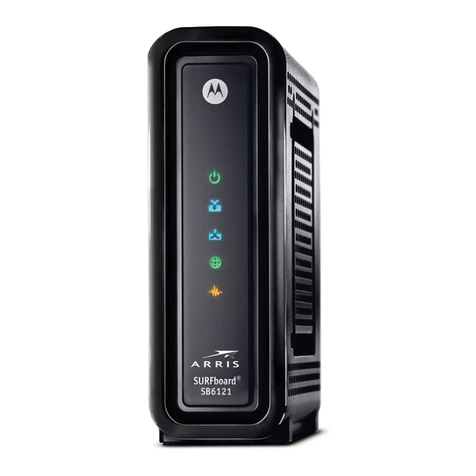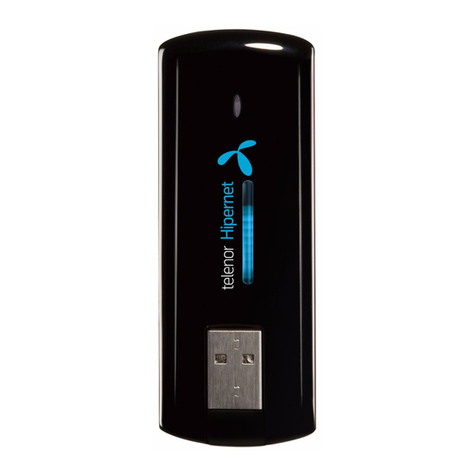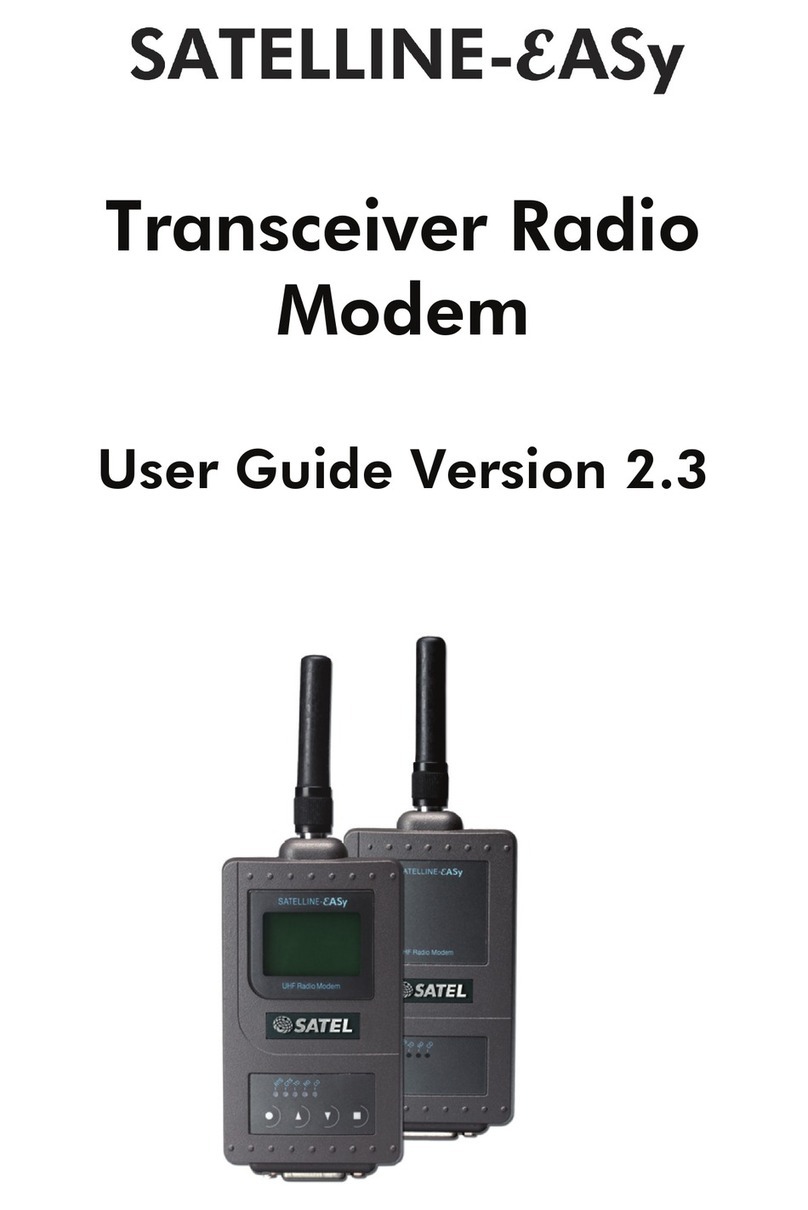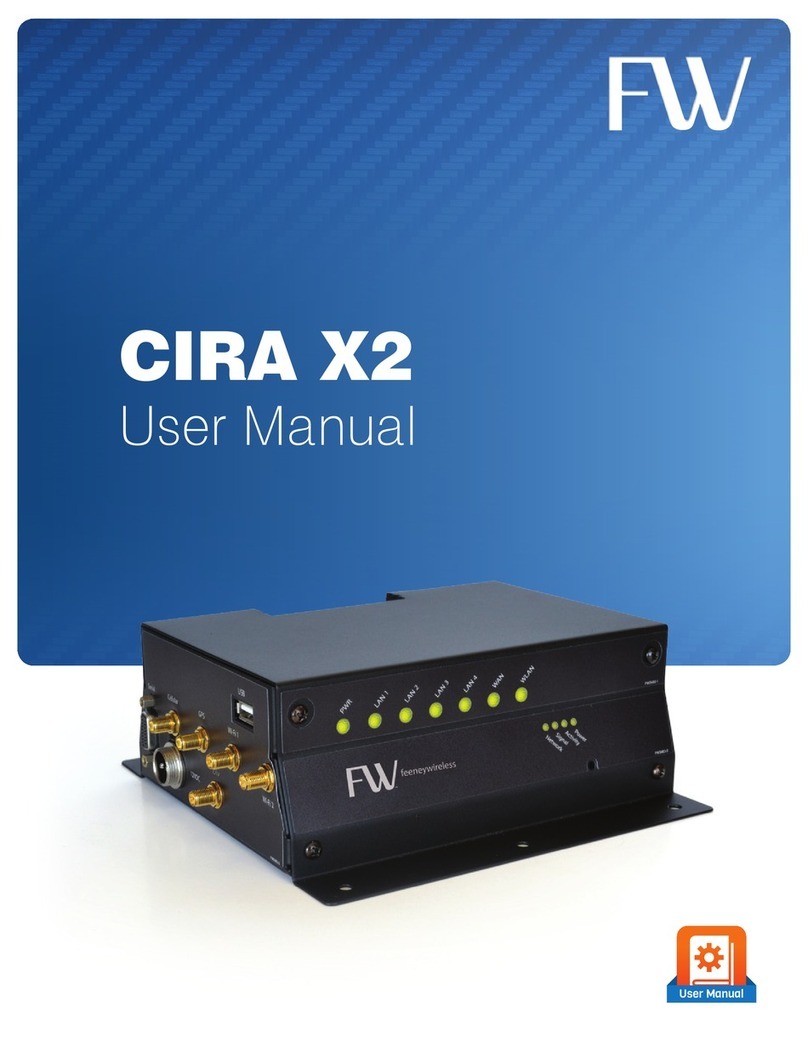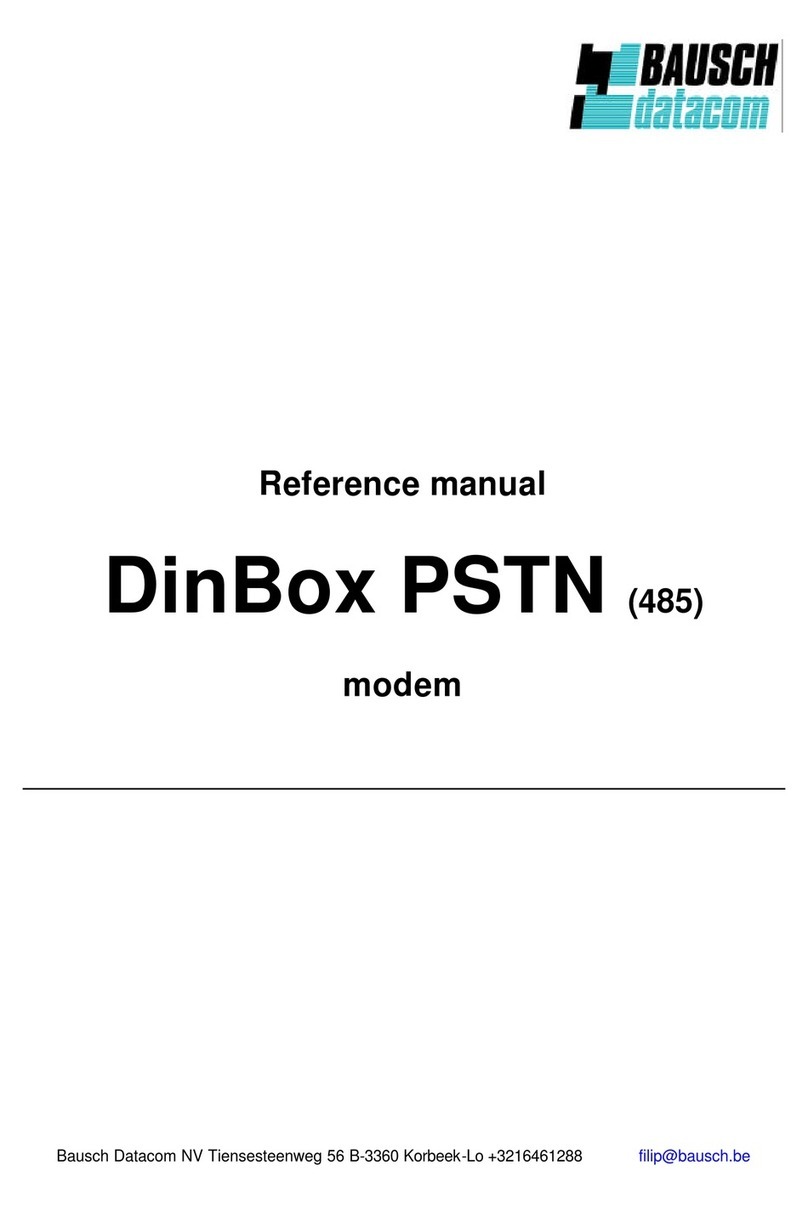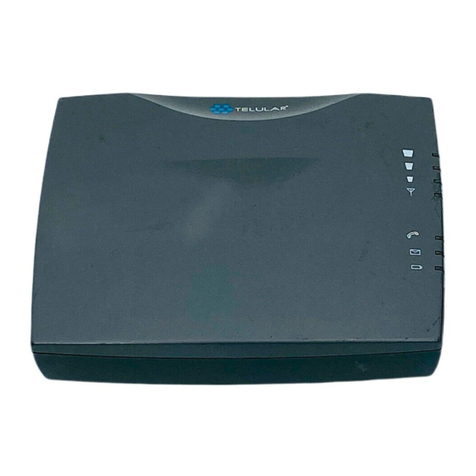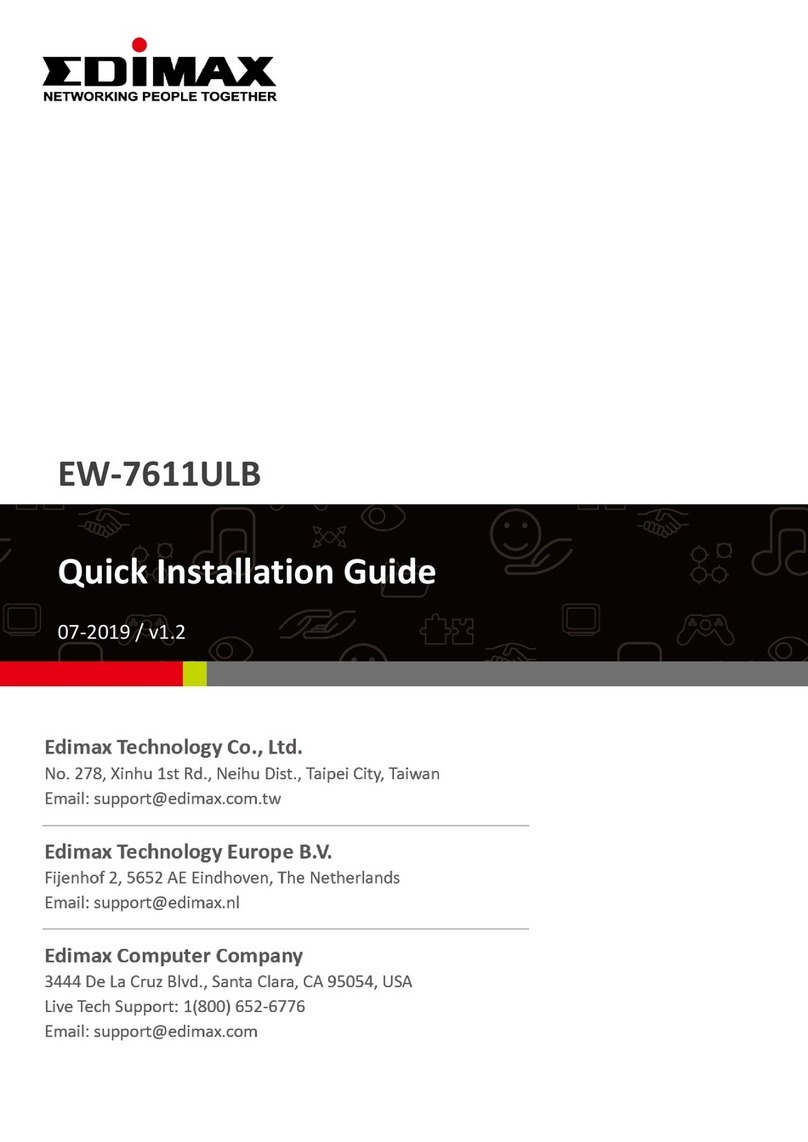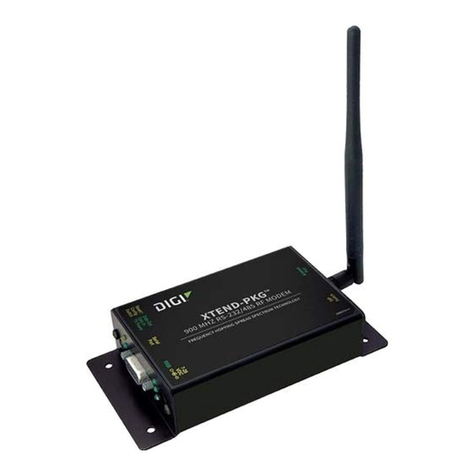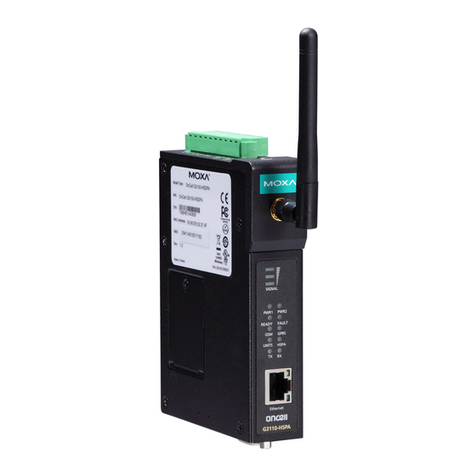TC Communications TC1720 User manual

Notice!
Althougheveryefforthasbeenmadetoinsurethatthismanualiscurrent
and accurate as of date of publication, no guarantee is given or implied
that this document is error free or accurate with regard to any specifica-
tion. TC Communications, Inc. reserves the right to change or modify
the contents of this manual at any time without prior notification.
TC1720
RS-422/RS-449 Async/Sync
FIBER OPTIC MODEM
(with Optional Dual Optics)
User's Manual
MODEL:
S/N:
DATE:
© COPYRIGHT 1992-2009. ALL RIGHTS RESERVED.
TC Communications, Inc. 17881 Cartwright Road, Irvine, CA 92614

TC1720
(Optional Dual Optics)
User's Manual
Rev. 1.4
-2-
Table of Contents
Chapter 1 - Overview ...................................................................................................3
Description.......................................................................................................................................... 3
Electrical Specifications ................................................................................................................... 3
Virtual Pin Assignments and Theory of Operation ....................................................................... 3
LEDs, DIP Switches and Connectors.............................................................................................. 4
DIP Switch Functions ........................................................................................................................ 5
Front Panel Switches ........................................................................................................................ 5
SW1 Internal PCB Dip Switches...................................................................................................... 5
RS-422/449 Termination Resistor ................................................................................................... 6
Optical Specifications ....................................................................................................................... 6
Optical Redundancy (optional) ........................................................................................................ 7
Dry Contact Alarm Relay................................................................................................................... 7
Power Supply and Rear Panel ......................................................................................................... 7
Chapter 2 - Installation ................................................................................................8
Unpacking the Unit ............................................................................................................................ 8
Equipment Location .......................................................................................................................... 8
Installation Procedure Summary ..................................................................................................... 8
Typical Point to Point Application Diagram .................................................................................... 9
Chapter 3 - Troubleshooting ...................................................................................... 10
General ..............................................................................................................................................10
All LEDs are "Off" .............................................................................................................................10
Alarm LED .........................................................................................................................................10
Optic Cable Types............................................................................................................................10
Calculating the Loss on the Fiber .................................................................................................10
RS-422/449 Cable Verification.......................................................................................................10
Important Warranty Note ................................................................................................................10
Optic Cable Verification ..................................................................................................................11
Chapter 4 - Bench Tests ............................................................................................ 12
General ..............................................................................................................................................12
Test Equipment Requirements ......................................................................................................12
Pre-Installation Tests.......................................................................................................................12
Local Electrical Loopback Test ......................................................................................................13
Local Optical Loopback Test ..........................................................................................................14
Remote Optical Loopback Test ......................................................................................................15
Remote Electrical Loopback Test ..................................................................................................16
Bench Test With Built-In Signal Generator..................................................................................17
Chapter 5 - Component Placement ............................................................................ 18
Chapter 6 - Specifications.......................................................................................... 19
Appendix A................................................................................................................ 20
Return Policy ....................................................................................................................................20
Warranty ............................................................................................................................................20

TC1720
(Optional Dual Optics)
User's Manual
Rev. 1.4
-3-
Chapter 1 - Overview
Description
The TC1720 RS-422/RS-449 is an economical and dependable fiber optic modem which links data
communication equipment requiring an RS-422A interface. It supports Asynchronous data speeds of up to
10 Mbps & Synchronous data speeds of up to 5 Mbps and is equipped with a male DB37 connector. A four-
position DIP switch provides for Remote & Local Loopback functions, Slave Clock operation & Alarm
disabling capability.
It is available in either rack mount or stand alone versions; the rack mount version can be converted to the
stand alone version with the addition of a sheet metal box. The TC1720 can communicate at distances up
to 4 km using Multimode optics and up to 80 km using Single Mode optics. Fiber optic connectors can be
eitherSTorFCtype.TC1720'sdesignutilizesadvancedFPGA(FieldProgrammableGateArray)technology
to increase reliability and flexibility.
TheTC1720 has multipleLED indicators toease installation andtroubleshooting. These LEDsindicate status
for power, operating voltage, alarm, transmit & receive electrical signals, optical signal and more.
Electrical Specifications
Interface: RS-422/RS-449 Async/Sync
Data Rates: Async Up to 10 Mbps
Sync Up to 5 Mbps
Connector: DB37 Male (DCE/DTE switch selectable)
Virtual Pin Assignments & Theory of Operation
Figure 1. Connecting a DTE to DCE Device
Logic Diagram
The TC1720 latches onto the RS-422/RS-449 data by the received clock signal (from user's equipment or
the internal clock generator from the TC1720) to produce an encoded optic signal (with an embedded clock).
The composite optic signal is then transmitted by the optic transmitter through the optic cable to a remote
TC1720'soptic receiver. The receivedoptic signal isprocessed and decodedto separate data and clock from
the composite optic signal and then transmitted out to a remote device.
Figure 2. Connecting a DTE to DTE Device
Logic Diagram
SD,SD
SD,SD
RD,RD
RD,RD
TT,TT
TT,TT
RT,RT
RT,RT
ST,ST
ST,ST
FRAME GND
FRAME GND
SIGNAL GND
SIGNAL GND
from DTE
device
to DCE
device
Fiber Cable
TC1720
DCE TC1720
DTE
4,22 4,22
6,24 6,24
17,35
8,26 8,26
17,35
5,23
1 1
19 19
5,23
Virtual Connection
(Connect DTE to DCE device)
SW3,
Slave clock
SD,SD
SD,SD
RD,RD
RD,RD
TT,TT
TT,TT
RT,RT
RT,RT
ST
ST
Transmit timing
(DCE sources)
Transmit timing
(DCE sources)
ST,ST
FRAME GND FRAME GND
SIGNAL GND SIGNAL GND
from DTE
device
toDTE
device
Fiber Cable
TC1720
DCE TC1720
DCE
4,22 4,22
6,24 6,24
17,35
8,26 8,26
17,35
11
19 19
55,23
23
Internal
Clock
generator
Virtual Connection
with Slave Clock

TC1720
(Optional Dual Optics)
User's Manual
Rev. 1.4
-4-
LEDs, DIP Switches and Connectors
Figure 3. TC1720's Front Panel
6
2
1
7
R
x
A
T
x
A
R
x
B
T
x
B
R
M
T
L
B
D
I
S
A
L
M
L
O
C
L
B
S
L
A
V
E
-
C
L
K
ASYNC/SYNC
FIBEROPTICMODEM
CTS
RxD
CD
TxD
CD
TxClkRxClk
RTS
P
W
R
A
A
L
A
R
M
V
c
c
P
W
R
B
R
x
-
A
U
S
E
-
B
D
T
E
R
x
-
B
MadeinU.S.A.
TCCOMM.COM
1
2
3
4
1
2
3
4
Connector for primary optic link
Connector for optional secondary optic link
Pins:
5
23 Sw3
Internalclock
“On” (down position)
“off” (up position)
Function of SW3 Slave clock
Alarm Indicator, Power Status &
Operating Voltage Status
Alarm (red):
off - normal operation
solid- major alarm condition (optic input lost)
flash- remote loopback activated by remote unit
PWR B: DC power supply from PWR B jack
Vcc: +5 VDC operating voltage power supply
PWR A: DC power supply from PWR A jack
received optic signal status
& DTE indicator
RxA:
- Solidly lit, when optic signal is received “OK” from primary
side (”A” side)
- Flashing, when optic signal lost
RxB:
- Solidly lit, optic received “OK” from secondary side (”B” side)
- Flashing, when optic signal lost or “B” side is not enabled
USE-B:
- Solidly lit, when secondary optic signal is being used due
to primary optic signal lost
- Off, secondary optic receiver is not enabled or primary
optic signal is being used.
DTE:
- Solidly lit, when unit is configured as DTE.
- Off, when unit is configured as DCE.
3
Switches to initiate (”down” position)
following tests and function:
RMTLB- turn on remote unit’s loopback
LOCLB- turn on local electrical interface’s loopback
SLAVE-CLK - Turns on Slave Clock mode: (RT=ST)
DISALM- disable alarm buzzer and relay
:
SLAVE-CLK Switch 3: - DTE it is not used.
- DCE when it is “on” (down position), it turns “on” the Slave-clock mode: (RT=ST).
when it is “off” (up position), it turns “on” the Internal clock mode: (ST=Internal clock) see table 1.
NOTE
status for received electrical signals
(from remote unit):
RD- “received data” (”TD”)
CTS- “clear to send”(”RTS”
CD- “carrier detect” (”CD”)
RCLK- “received clock” (”TxClk”)
4
5
Statusfor electrical signalfrom
local user’s device:
TxD- “transmit data”
RTS- “request to send”
CD- “carrier detect”
TxClk- “transmit clock”

TC1720
(Optional Dual Optics)
User's Manual
Rev. 1.4
-5-
DIP Switch Functions
For troubleshooting purpose, user can conduct remote loopback and local loopback test. TC1720 also has
a built-in signal generator for user to validate fiber optic link. There are two groups of DIP switches: one
at the front panel, the other one is located at the center of the PC board.
Front Panel Switches
There are four DIP switches located at the front panel. Usually, they are very
useful during installation or troubleshooting. They are described as follows:
DIP #1: Remote loop back. This switch (DIP #1) initiates the Remote loop
back function. The composite optic signal is received from optic "RxA"
and decoded, then looped back to optic "TxA."
DIP #2: Local loop back (for diagnostic use). When DIP #2 is pressed down, an electrical signal loop
is created, the input electrical signal is converted to the TTL level and looped back.
DIP #3: Internal clock generator "off" when DIP #3 is in the up(off) position. When switched to the down
("on") position, the received clock signal (from the remote side) is also used as an internal clock
signal and is transmitted to the user's equipment.
DIP #4: Disable dry contact alarm.
These functions can be initiated from one of four DIP switches accessible from front panel. Under normal
operation, all the switches should be set in "UP" position.
SW1 Internal PCB Dip Switches
Thereare other eightDIP switches locatedat the PC boardand can notbe accessed fromfront panel. These
switches are usually only used during installation.
SW1-1: Enable signal generators. This switch initiates the built-in Signal Generator function. The unit
will generate a visual signal to verify optic link.
SW1-2: Configure TC1720's interface as a DCE or DTE. Off: DCE On: DTE
SW1-3: Enable RxB. (On dual fiber optic models only)
SW1-4: Async/Sync. Configure unit as Async or Sync. On: Async Off: Sync
Table 1. TC1720 Internal Clock Settings (Internal SW1)
SW1-5:
For Oscillator: 8.192Mhz
SW1-7:
SW1-6:
SW1-8:
Note: DIP Switches SW1-5 through SW1-8 are used for the internal clock generator. If the internal clock
from the TC1720 will be utilized, a clock rate can be selected according to the following table.
R
M
T
L
B
D
I
S
A
L
M
L
O
C
L
B
S
L
A
V
E
-
C
L
K
1
2
3
4
1 2
3
4
Legend:
This table shows the
Internal Clock speed
when the TC1720 is
DCE, on DB37 pin 5
& 23.
X = ON
8k 9.6k 16k 19.2k 32k 38.4k 56k 64k 128k 256k
5 - 10M
2.048M512k 1.024M 4.096M
x
x
x
x
x
x
x
x
x
x
x
x
x
x
x
x
x
x
x
x
x
x
x
x
x
x
x
x
x
x
x
x
012345678 910 11 12 13 14 15
ON
Internal
DIP
Switches
(SW1)
1234567
8

TC1720
(Optional Dual Optics)
User's Manual
Rev. 1.4
-6-
Optical Specifications
The following measurements are based on Async data rates of up to 10Mbps.
Transmitter: LED/ELED; typical Launch Power: -19dBm* (1310nm Multimode, @62.5/125µm)
-16dBm* (1310/1550nm Single Mode, @9/125µm)
Receiver: PIN Diode; typical Sensitivity: -34dBm* (1310nm Multimode, @62.5/125µm)
-36dBm* (1310/1550nm Single Mode, @9/125µm)
Loss Budget: 1310nm MM, @62.5/125µm: 15dB
1310/1550nm SM, @9/125µm: 20dB
Distance: 1310nm Multimode, @62.5/125µm: up to 4km distance*
1310nm Single Mode, @9/125µm: up to 50km distance*
1550nm Single Mode, @9/125µm: up to 80km distance*
*Launch power, sensitivity and distance are listed for reference only. These numbers may vary.
RS-422/449 Termination Resistor
A termination resistor is usually necessary for RS-422 applications. Without proper termination, the error
rate of data transmission may be high due to an “echo” effect on the electrical connection. With the addition
of a termination resistor at the beginning or end of the electrical bus, this echo effect is greatly reduced. The
termination resistors are 100 to 130 ohm resistors located inside the TC1720. Two jumpers, identified as
boardlocations“JP2”&“JP3,”controltheterminationresistanceoneachunit. “JP3”controlstheresistance
for the unit’s receiver, while “JP2” controls the transmitter’s resistance. Proper line termination is usually
accomplished by leaving the “JP3” jumper intact at both ends of the link.

TC1720
(Optional Dual Optics)
User's Manual
Rev. 1.4
-7-
Optical Redundancy (optional)
Ifopticredundancywasordered with the unit, figure belowappliestoitsoperation. Opticredundancy is used
to prevent the loss of data transmission in the event an optic cable, transmitter, or receiver is broken or
degraded. Should this occur, the secondary optic link & receiver "B" is enabled automatically, thereby
preserving the integrity of the communication. In the meantime, the "Alarm" LED will flash and the buzzer
will sound to indicate a cable breakage.
Whenthe unit isequipped with opticredundancy,
the optic transmitter "TxA" and "TxB" both
transmit the same signal to the remote unit. It is
up to the remote unit to decide whether "RxA" or
"RxB" should be used as the valid incoming optic
signal. By default, "RxA" is the primary re-
ceiver; "RxB" is the stand by backup.
Figure 4. TC1720's Rear Panel
Dry Contact Alarm Relay
A terminal block connector at the rear panel
provides for the Dry Contact Alarm Relay. Nor-
mally in the OPEN position, any alarm condition
will force the switch to a CLOSED position. This
relay can be used in conjunction with an external
device to signal an alarm condition.
Power Supply and Rear Panel
The TC1720 consumes very low power. The standard input voltage is from 12VDC and current is 500mA
(max). You may use an external power adapter with the following specifications: 12V DC @800mA (positive
polarity at the left terminal when viewed from the rear panel).
The power plug can be connected into either power jack on the rear panel. Because the TC1720 is equipped
with a built-in power redundancy feature, the "POWER A" or "POWER B" LEDs on the front panel will
illuminate according to which power source the unit is drawing from. If power redundancy is utilized, both
LEDs will light.
For units with the -48V DC power supply option, a DC-to-DC converter is installed inside the unit. The DC
current requirement for the optional -48V DC power supply is @50mA.
RxA
Rx
RxB
Optic Signal
Detector
&
Automatic
Switchover
Control
TxA
Tx
TxB
TC1720
TxA
Tx
RxA
Rx
TxB
RxB
Optic Signal
Detector &
Auto Switch Over
Control
TC1720
TC1720
ALARMRS-449
1 19
20 37
PWR
APWR
B
+ -
+ -
Terminal Block Connectors
for Power Supply "A" & "B" DB37 Male
Connector
Dry Contact Alarm
Relay Connector
24VDC12VDC 125VDC48VDC

TC1720
(Optional Dual Optics)
User's Manual
Rev. 1.4
-8-
Chapter 2 - Installation
Unpacking the Unit
Before unpacking any equipment, inspect all shipping containers for evidence of external damage caused
during transportation. The equipment should also be inspected for damage after it is removed from the
container(s). Claimsconcerningshipping damage should bemadedirectlyto the pertinent shippingagencies.
Any discrepancies should be reported immediately to the Customer Service Department at TC Communi-
cations, Inc.
Equipment Location
The TC1720 should be located in an area that provides adequate light, work space, and ventilation. Avoid
locating it next to any equipment that may produce electrical interference or strong magnetic fields, such as
elevator shafts, heavy duty power supplies, etc. As with any electronic equipment, keep the unit from
excessive moisture, heat, vibration, metallic particles and freezing temperatures. Installation Procedure
Summary
Installation Procedure Summary
The TC1720 is designed for quick and easy installation. Before installing, however, make sure all DIP
switches are in the up ("Off") position and double-check the polarity at the DC power's terminal block
connector. The installation procedure is as follows:
1. Connect your DTE/DCE Device to the DB37 Connector: Check the Pin Assignments on page 3
and verify your application's data rate. Shielded cable is recommended.
2. Connect the optic cables: Connect the local unit's optic "TxA" to the remote unit's optic "RxA".
Connect the local unit's optic "RxA" to the remote unit's optic "TxA." (do the same for "TxB" and "RxB"
on Dual Optics Models).
3. Connect the power plug:The plug can be connected into either power terminal "A" or "B" (check for
proper polarity). The unit is equipped with power redundancy. By plugging a second power supply to
the spare power terminal, power redundancy is enabled. Verify that the power "A" and/or "B" LED is
illuminated.
4. Turn "On" your device:If your device is a DTE/DCE device, the "TxD" & "TxClk" LEDs on the local
unit should be illuminated, meaning the signal is being transmitted. On the remote unit, the "RxD" &
"RxClk" LEDs should be illuminated, meaning the signal is being received.
5. Check the "Rx-A" LEDs:When a good optic signal is received, the "Rx-A" LED on the corresponding
unit should illuminate. (Check "Rx-B" LED when "Optic TxB" and "Optic RxB" are in use. Dual Optics
model only).

TC1720
(Optional Dual Optics)
User's Manual
Rev. 1.4
-9-
After installation is complete, it is an excellent idea to verify and record the optical cable loss. This reading
will both verify the integrity of the system and provide a benchmark for future troubleshooting efforts (see
Chapter 3 - Troubleshooting).
Figure 5. Typical Point-to-Point RS-442/449 Application Diagram
DTE
DEVICE
(Dual Optic Models only)
RS 422/449 F/O
MODEM
DTE
DEVICE
RS
422/
449
RS
422/
449
RS
422/
449
OPTIC
TxB
OPTIC
RxB
OPTIC
TxA
OPTIC
TxB
OPTIC
RxB
OPTIC
TxA
OPTIC
RxA
RS 422/449 F/O
MODEM
OPTIC
RxA
RS
422/
449

TC1720
(Optional Dual Optics)
User's Manual
Rev. 1.4
-10-
Chapter 3 - Troubleshooting
General
Typically, most problems encountered during installation are related to an improperly wired RS-442/449 cable
or a break in the integrity of the fiber optic link (cable or connectors).
All LEDs are "Off"
If no LEDs are lit on the unit, check the DC power supply, terminal block connector plug, and/or power
source. If the problem persists, contact the Technical Support Department at TC Communications, Inc.
Alarm LED
When there is an alarm condition, the red "ALARM" LED will be lit and the "RxA" LED will also flash to
indicate the optic signal has been lost. The Alarm will also trigger the dry contact relay switch.
Optic Cable Types
Conventionally, fiber optic cable with yellow-colored insulation is used for single mode applications; gray or
orange-colored insulated cable is for multimode use. If multimode cable is used in a single mode application,
the test results could be erroneous and confusing.
Calculating the Loss on the Fiber
The fiber optic link and/or the connectors are frequently the source of communication problems. If problems
are present, check the optic connectors and the integrity of the link first. Ideally, the link should be calibrated
for total loss after the installation has been completed. This will accomplish two things: (1) it will verify that
the total loss of the link is within the loss budget of the device and (2) it will provide a benchmark for future
testing. For example, a system that has been tested as having 6dB of signal loss when installed should not
suddenly test out as having a loss of 10dB. If this were the case, however, the fiber link or connector would
probably be the source of the problem.
These are the reference values we use to calculate the loss on the fiber:
Multimode 1310nm :2 dB loss per km on 62.5/125µm cable*
Single Mode 1310nm :0.5 dB loss per km on 9/125µm cable*
Single Mode 1550nm :0.25 dB loss per km on 9/125µm cable*
*These numbers are listed for reference only. We recommend an OTDR reading be used to measure actual link loss.
RS-442/449 Cable Verification
1. Make sure the electrical signal connections match the pin assignments for the device (refer to page 3
for DCE/DTE pin connections). Verify signal connections by checking the status LEDs on the front panel
oftheTC1720. VerifythatthepinsignalconnectionsmatchtheappropriateLEDresponses(seeFigures
1, 2 & 3).
2. Be sure that all switches are set correctly. All the front panel DIP switches should be in up (off) position.
All the "SW1 Internal DIP Switches" are generally factory configured. However, the clock settings can
be user configured with SW1-5, SW1-6, SW1-7, and SW1-8, to suit the user's timing needs, refer to table
1 on page 5.
Important Warranty Note:
If the need arises for any internal configuration, please contact the Technical Support Department at TC
Communications, Inc @ (949) 852-1973. Warranty voided if product seal is broken.

TC1720
(Optional Dual Optics)
User's Manual
Rev. 1.4
-11-
Optic Cable Verification
If the "Rx-A" LED on the front panel is flashing (or off), this is an indication that the optic signal is not being
correctly received. Usually, unsecured fiber optic connectors or faulty cable are to blame. A good
connectionisindicatedbythe"Rx-A"LEDonthefrontpanelbeingsolidlylit. Thisindicatesthatthereceiving
cable is correctly connected to the remote unit's optic "TxA."
On Dual Optics Models, the same applies to "RxB" and "TxB." Dual Optics Models will automatically switch
to optic "RxB" if optic "RxA" is not receiving a valid signal. This automatic switchover enables the user to
verifythe"B" fiber connection by simply disconnectingthe"A"fiber connection, thereby verifying the optical
redundancy capability of the unit. (Dual Optics is an optional feature).

TC1720
(Optional Dual Optics)
User's Manual
Rev. 1.4
-12-
Chapter 4 - Bench Tests
General
It is highly recommended to conduct a bench test before actual installation. A bench test will allow the user
to get familiar with all the functions and features of the TC1720 in a controlled environment. Knowledge
of the TC1720's functions and features will facilitate installation and troubleshooting efforts later on.
Test Equipment Requirements
End user equipment required for testing:
1. One BERT (Bit Error Rate Tester) test set with a DB37 Female adapter and appropriate interface
module (match pin assignments with the diagrams on page 3).
2. Two short optical cable jumpers with appropriate connectors (ST or FC).
Pre-Installation Tests
1. Make sure the appropriate power supply accompanies the TC1720 unit (see page 7).
2. To verify that the unit functions properly, plug in only the power connector to the terminal (be sure to
observe correct polarity), without having any other cable connections to the unit.
3. Onthe front panel,theappropriate green "PowerA" or "Power B"LED should beilluminated(depending
on whether you plug into the "A" or "B" terminal on the back of the unit). Both lights should be on if you
utilize power redundancy (power is connected to both "A" and "B" terminals on the rear panel).
4. The "ALARM" and "Rx-A" LEDs should be flashing.
5. The "Vcc" LED should be illuminated. Please note: all other LEDs can be in a random state (flashing,
solidly lit, or off) as only upon proper receipt and transmission of a signal will the TC1720 set its LEDs
appropriately for normal operation.

TC1720
(Optional Dual Optics)
User's Manual
Rev. 1.4
-13-
Local Electrical Loopback Test
1. Set up the bench test as illustrated in Figure 6 below.
2. Make sure your BERT tester is turned on and configured as an RS-422/499 DTE device if the unit is
DCE.
3. Connect the DB37 female adapter (check pin assignments on page 3) from the BERT tester to the
TC1720’s DB37 male connector (on the rear panel).
4. SettheBERT test set to thesame(oras close to thesame)datarate as the application youplantoconnect
to (typically 19.2Kbps through 128Kbps Synchronous).
5. The data bits should be selected as ‘8 bits’ and the data pattern should be set to ‘2047’ on the BERT
tester.
6. At this point, the following LEDs should be observed on the TC1720 unit: The "TxD," "TxClk," "PWRA
or PWRB," "Vcc," and "ALARM" should be solidly lit. Note, the "ALM" LED will be solidly lit and the
"RxA" LED will be flashing since there is no optical fiber cables connected. All other LEDs should be
off.
7. Now, turn the front panel SW2-2 (LOCLB) dip switch to the down "On" position to enable the Local
Loopback test function.
8. At this point, the tester should indicate a Synchronous signal being received indicating that the RS-422/
449 electrical signal is transmitted and received okay.
9. Verify that the "TxD," "RxD," "TxClk," "RxClk," "ALARM," "PWRA or PWRB," and "Vcc" LEDs are
solidly lit. Note, the "ALM" LED will be solidly lit and the "RxA" LED will be flashing since there is no
optical fiber cables connected. All other LEDs should be off.
You should not see any bit errors. To verify this, inject an error using the BERT tester to see if it will
be recorded by the tester, then verify that no additional errors appear after the user injected error.
10.When done with this test, make sure to return the front panel SW2-2 (LOCLB) dip switch to the up "Off"
position to disable the Local Loopback test function and proceed with other tests.
Figure 6. Local Electrical Loopback Test Connection Diagram
ALARM
DB37 Female
Cable
BERT Test Set
with RS-422/449
RS-422/449
ASYNC/SYNC
FIBER OPTIC MODEM
TxB TxARxB
OPTIC OPTIC
(Optional)
RxA
PWR
A
PWR
B
DC Power Supply
12VDC@ 500mA
Male DB37

TC1720
(Optional Dual Optics)
User's Manual
Rev. 1.4
-14-
Local Optical Loopback Test
To perform this local optical test, all the front panel SW2 dip switches should be to the up "Off" position.
1. Set up the bench test as illustrated in Figure 7 below. Make sure to use the correct type of fiber optical
jumper cables (either Single Mode or Multimode according to the specifications of the TC1720s).
2. Make sure your BERT tester is turned on and configured as an RS-422/499 DTE device if the unit is
DCE.
3. Connect the DB37 female adapter (check pin assignments on page 3) from the BERT tester to the
TC1720’s DB37 male connector (on the rear panel).
4. SettheBERT test set to thesame(oras close to thesame)datarate as the application youplantoconnect
to (typically 19.2Kbps through 128Kbps Synchronous).
5. The data bits should be selected as ‘8 bits’ and the data pattern should be set to ‘2047’ on the BERT
tester.
6. At this point, the tester should indicate a Synchronous signal being received indicating that the RS-422/
449 electrical signal is transmitted and received okay.
7. Verify that the "TxD," "RxD," "TxClk," "RxClk," "RxA," "PWRA or PWRB," and "Vcc" LEDs are solidly
lit on the TC1720. Note, the "ALARM" LED will be "Off" since there is optical fiber cable(s) connected.
All other LEDs should be off.
You should not see any bit errors. To verify this, inject an error using the BERT tester to see if it will
be recorded by the tester, then verify that no additional errors appear after the user injected error.
Figure 7. Local Optical Loopback Test Connection Diagram
ALARM
DB37 Female
Cable
BERT Test Set
with RS-422/449
RS-422/449
ASYNC/SYNC
FIBER OPTIC MODEM
TxB TxARxB
OPTIC
(Optical redundant
models only)
OPTIC
(Optional)
RxA
PWR
A
PWR
B
DC Power Supply
12VDC@ 500mA
Male DB37

TC1720
(Optional Dual Optics)
User's Manual
Rev. 1.4
-15-
Figure 8. Remote Optical Loopback Test Connection Diagram
Remote Optical Loopback Test
1. Connect a second TC1720 unit. As with the first unit, from doing the local optical loopback test, follow
the bench test steps on the previous page. When you have completed the local optical loopback test for
the second unit, proceed to the next step.
2. Set up the bench test as illustrated in Figure 8 below.
3. SettheBERT test set to thesame(oras close to thesame)datarate as the application youplantoconnect
to (typically 19.2Kbps through 128Kbps Synchronous).
4. The data bits should be selected as ‘8 bits’ and the data pattern should be set to ‘2047’ on the BERT
tester.
5. Now, on theLocalUnitOnly, turn the front panel SW2-1 (RMTLB) dip switch to the down "On" position
to enable the Remote Loopback Test function. All other dip switches must be up or Off. On the Remote
TC1720 all dip switches must be up or Off.
6. At this point, the tester should indicate a Synchronous signal being received (if the optical cable and
connectors are good and the cable has been connected properly).
7. Verify the following LEDs on both the Local and Remote TC1720 units:
On the Local unit, the "TxD," "RxD," "TxClk," "RxClk," "RxA," "PWRA or PWRB," and "Vcc" LEDs
are solidly lit. The "ALARM" LED and all other LEDs will be off.
On the Remote unit,the"TxD," "RxD,""TxClk,""RxClk,""RxA," "PWRA or PWRB," and "Vcc"LEDs
are solidly lit. The "ALARM" LED will be in a flashing mode, indicating the unit is diagnostic mode.
You should not see any bit errors. To verify this, inject an error using the BERT tester to see if it will
be recorded by the tester, then verify that no additional errors appear after the user injected error.
8. When done with this test, make sure to return the Local unit's front panel SW2-1 (RMTLB) dip switch
to the up "Off" position to disable to Remote Optical Loopback test function to proceed with other tests.
ALARM
ALARM
BERT Test Set
with RS-422/449
Local
unit Remote
unit
RS-422/449 RS-422/449
ASYNC/SYNC
FIBER OPTIC MODEM ASYNC/SYNC
FIBER OPTIC MODEM
TxB TxBTxA TxA
RxB RxB
(Optical redundant
models only)
Only
SW2-1 Dip
Down
All
SW2 Dip
Up
DB37 Female
Cable
OPTIC OPTICOPTIC OPTIC
(Optional) (Optional)
RxA RxA
PWR
APWR
A
PWR
BPWR
B
DC Power Supply
12VDC@ 500mA
DC Power Supply
12VDC@ 500mA
Male DB37 Male DB37

TC1720
(Optional Dual Optics)
User's Manual
Rev. 1.4
-16-
Remote Electrical Loopback Test
1. Set up the bench test as illustrated in Figure 9 below. Make sure all front panel SW2 dip switches on both
the Local & Remote TC1720's are to the up "Off" position.
2. Connect four copper-wire jumpers to short (loopback) the DB37 Male connector on the rear of the
remote unit as follows (these copper-wire connections will loopback the signal at the remote TC1720):
3. SettheBERT test set to thesame(oras close to thesame)datarate as the application youplantoconnect
to (typically 19.2Kbps through 128Kbps Synchronous).
4. The data bits should be selected as ‘8 bits’ and the data pattern should be set to ‘2047’ on the BERT
tester.
5. At this point, the tester should indicate a Synchronous signal being received (if the optical cable and
connectors are good and the electrical cable has been connected properly).
6. Verify that the "TxD," "RxD," "TxClk," "RxClk," "RxA," "PWRA or PWRB," and "Vcc" LEDs are solidly
litonboththeLocalandRemoteTC1720s.Note,the"ALARM" LED will be "Off" since there are optical
fiber cables connected. All other LEDs should be off.
You should not see any bit errors. To verify this, inject an error using the BERT tester to see if it will
be recorded by the tester, then verify that no additional errors appear after the user injected error.
Pin 4 (+SD) to Pin 6 (+RD)
Pin 22 (-SD) to Pin 24 (-RD)
Pin 17 (+TT) to Pin 8 (+RT)
Pin 35 (-TT) to Pin 26 (-RT)
Figure 9. Remote Electrical Loopback Test Connection Diagram
ALARM
ALARM
BERT Test Set
with RS-422/449
Local
unit Remote
unit
RS-422/449 RS-422/449
ASYNC/SYNC
FIBEROPTICMODEM ASYNC/SYNC
FIBER OPTIC MODEM
TxB TxBTxA TxARxB RxB
(Optical redundant
models only)
DB37 Female
Cable
OPTIC OPTICOPTIC OPTIC
(Optional)
Pin4(SD)toPin6(RD)
Pin22(SD)toPin24(RD)
Pin17(TT)toPin8(RT)
Pin35(TT)toPin26(RT)
(Optional)
RxA RxA
PWR
APWR
A
PWR
BPWR
B
DC Power Supply
12VDC@ 500mA
DC Power Supply
12VDC@500mA
Male DB37 Male DB37

TC1720
(Optional Dual Optics)
User's Manual
Rev. 1.4
-17-
Figure 10. Signal Generator Bench Test Connection Diagram
Bench Test With Built-In Signal Generator
The TC1720 has built-in signal generator to simulate a polling device's incoming electrical signal. The built
-in signal generator is a pulse signal indicated by blinking LED. The flash rate is intentionally reduced for
easy visual confirmation.
Thepurpose of theSignalGenerator Test isto verify the opticalconnections and the clocksignal of the units.
Important Note:
Before proceeding with the Signal Generator test, please read the Warranty Note on page 10.
1. Setup the bench test as shown in Figure 10.
2. At the local TC1720 unit, turn on the "SIG-GEN" by sliding SW1-1 (switch 1 of the "SW1 Internal DIP
Switch") to the right (on) position.
2a. For "Sync" units(SW1-4: disabled "Off"): Turn on the "RMTLB" by pressing down the DIP switches #1
of "Front Panel DIP Switches" on the Local TC1720. The "TxD & RxD," "RTS & CTS," "CD & CD,"
"TxClk & RxClk" LEDs on the local TC1720 should light sequentially from top to bottom. Likewise, the
same flashing LED sequence should be observed on the Remote TC1720 indicating receipt of the local
unit's simulated response.
3. When done with this test, turn off the "SIG-GEN" by sliding SW1-1 (switch 1 of the "SW1 Internal DIP
Switch") to the left (off) position.
ALARM
ALARM
Local
unit Remote
unit
RS-422/449
RS-422/449
ASYNC/SYNC
FIBER OPTIC MODEM ASYNC/SYNC
FIBER OPTIC MODEM
TxB TxBTxA TxA
RxB RxB
(Optical redundant
models only)
OPTIC OPTIC
OPTIC OPTIC
(Optional) (Optional)
RxA RxA
PWR
APWR
A
PWR
BPWR
B
DC Power Supply
12VDC@500mA
DC Power Supply
12VDC@ 500mA
Male DB37 Male DB37

TC1720
(Optional Dual Optics)
User's Manual
Rev. 1.4
-18-
Chapter 5 - Component Placement
Figure 11. Component Locations on TC1720's Internal PCB (with optional Dual Optics)
INTERFACE MODULE
DB37 Male connector
for electrical signal connection
TERMINAL
BLOCK
CONNECTORS
+
+
--
FPGA configuration
EEPROM
fuses
U4
F1
POWER B POWER A
(12 - 14VDC) @500mA
F2
JP2
FPGA
chip
Trim-pot to adjust optic launch power:
Clockwise to increase optic power;
counter-clockwise to decrease optic power.
Optic “RxB (optional)
Optic “TxB” (optional) Optic“TxA” Optic“RxA”
DRY
CONTACT
ALARM
SW1
12345678
ON
SW1 Internal DIP Switches
Used to configure TC1720:
to enable the signal generator test,
to change DCE (Off) or DTE (On) device,
to enable secondary optic receiver, and
to select the internal clock rate.
SW1-1: enable signal generators
SW1-2: configure TC1720’s interface as DCE or DTE
SW1-3: enable RxB
SW1-4: enable Async/Sync mode
SW1-5:
SW1-6:
SW1-7:
SW1-8:
4
3
2
1
SW2
8k
9.6k
16k 19.2k 32k
38.4k
56k 64k 128k 256k 512K
1.024M
2.048M
4.096M
5 - 10M
x
x
x
x
x
x
x
x
x
x
x
x
x
x
x
x
x
x
x
x
x
x
x
x
x
x
x
x
x
x
x
x
0123456 7 8 9 10 11 12 13 14 15
Legend:
X = ON
This table shows the
Internal Clock speed
when the TC1720 is
DCE, on DB37 pin 5
& 23.
For Oscillator: 8.192Mhz

TC1720
(Optional Dual Optics)
User's Manual
Rev. 1.4
-19-
Chapter 6 - Specifications
Data Rates
Asynchronous......................................................................................... Up to 10 Mbps
Synchronous............................................................................................. Up to 5 Mbps
Optical
Transmitter ................................................................................... LED/LASER with AGC
Receiver .......................................................................................................... Pin Diode
Wavelength ....................................................................................... 1310nm Multimode
.............................................................................................. 1310/1550nm Single Mode
Connector .......................................................................................................ST* or FC
Loss Budget** ...................................................15dB Multimode 1310nm @62.5/125µm
................................................................... 20dB Single Mode 1310/1550nm @9/125µm
Electrical
Interface ...................................................................................................RS-422/RS-449
Connector ...................................................................................................... DB37 Male
System
Bit Error Rate ........................................................................................1 in 109or better
Indicators
System status............................ALARM, PWR A, PWR B, Vcc, Rx-A, Rx-B, USE-B, DTE
Electrical Signal Status ....................................................................................RxD, TxD
Optic Signal Status...................................... TxA, RxB (for Dual Optics, TxB and RxB)
Power Source
Standard.................................................................................. 12VDC @500mA (typical)
Optional .......................... 24VDC, 48VDC, or 115/230VAC with an external power cube
Temperature
Operating ................................................................................................... -10oC to 50oC
..................................................................... Hi-Temp Version (optional) -20oC to 70oC
............................................................ Extreme-Temp Version (optional) -40oC to 85oC
Storage....................................................................................................... -40oC to 90oC
Humidity........................................................................................ 95% non-condensing
Physical (Rackmount Card)
Height ......................................................................................................(3.53 cm) 1.39"
Width ......................................................................................................(18.13 cm) 7.14"
Depth ......................................................................................................(16.59 cm) 6.53"
Weight ...................................................................................................(192 gm) 5.44 oz
*ST is a trademark of AT&T
**Contact factory for loss budget requirements greater than 20dB (Laser version).

TC1720
(Optional Dual Optics)
User's Manual
Rev. 1.4
-20-
Appendix A
Return Policy
To return a product, you must first obtain a Return Material Authorization number from the Customer
Service Department. If the product’s warranty has expired, you will need to provide a purchase order to
authorize the repair. When returning a product for a suspected failure, please provide a description of the
problem and any results of diagnostic tests that have been conducted.
Warranty
Damages by lightning or power surges are not covered under this warranty.
All products manufactured by TC Communications, Inc. come with a five year (beginning 1-1-02)
warranty. TC Communications, Inc. warrants to the Buyer that all goods sold will perform in accordance
with the applicable data sheets, drawings or written specifications. It also warrants that, at the time of sale,
the goods will be free from defects in material or workmanship. This warranty shall apply for a period of
five years from the date of shipment, unless goods have been subject to misuse, neglect, altered or destroyed
serialnumberlabels,accidents(damagescausedinwholeorinparttoaccident,lightning,powersurge,floods,
fires, earthquakes, natural disasters, or Acts of God.), improper installation or maintenance, or alteration or
repair by anyone other than Seller or its authorized representative.
Buyer should notify TC Communications, Inc. promptly in writing of any claim based upon warranty, and
TC Communications, Inc., at its option, may first inspect such goods at the premises of the Buyer, or may
give written authorization to Buyer to return the goods to TC Communications, Inc., transportation charges
prepaid, for examination by TC Communications, Inc. Buyer shall bear the risk of loss until all goods
authorized to be returned are delivered to TC Communications, Inc. TC Communications, Inc. shall not be
liable for any inspection, packing or labor costs in connection with the return of goods.
In the event that TC Communications, Inc. breaches its obligation of warranty, the sole and exclusive
remedy of the Buyer is limited to replacement, repair or credit of the purchase price, at TC Communications,
Inc.’s option.
To return a product, you must first obtain a Return Material Authorization (RMA) number and RMA form
from the Customer Service Department. If the product’s warranty has expired, you will need to provide a
purchaseordertoauthorize the repair. When returning a product forasuspectedfailure,pleasefill out RMA
form provided with a description of the problem(s) and any results of diagnostic tests that have been
conducted. The shipping expense to TC Communications should be prepaid. The product should be properly
packaged and insured. After the product is repaired, TC Communications will ship the product back to the
shipper at TC's cost to U.S. domestic destinations. (Foreign customers are responsible for all shipping costs,
duties and taxes [both ways]. We will reject any packages with airway bill indicating TC communications
is responsible for Duties and Taxes. To avoid Customs Duties and Taxes, please include proper documents
indicating the product(s) are returned for repair/retest).
Table of contents
Other TC Communications Modem manuals
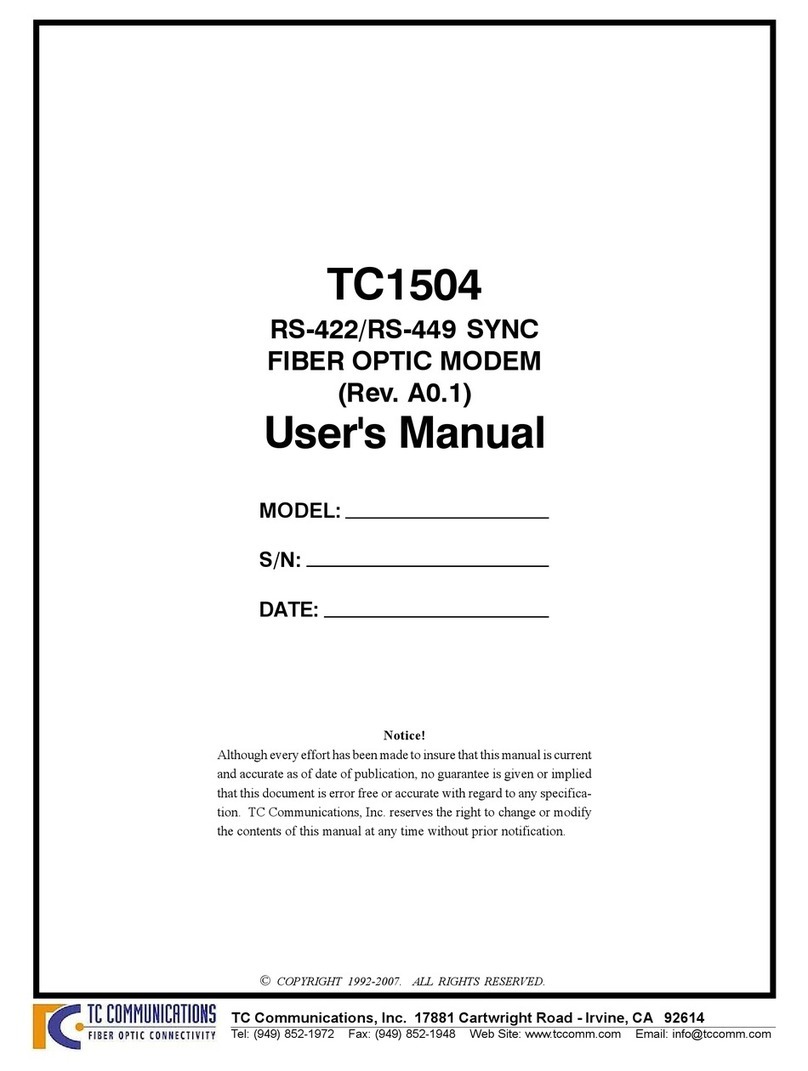
TC Communications
TC Communications TC1504 User manual
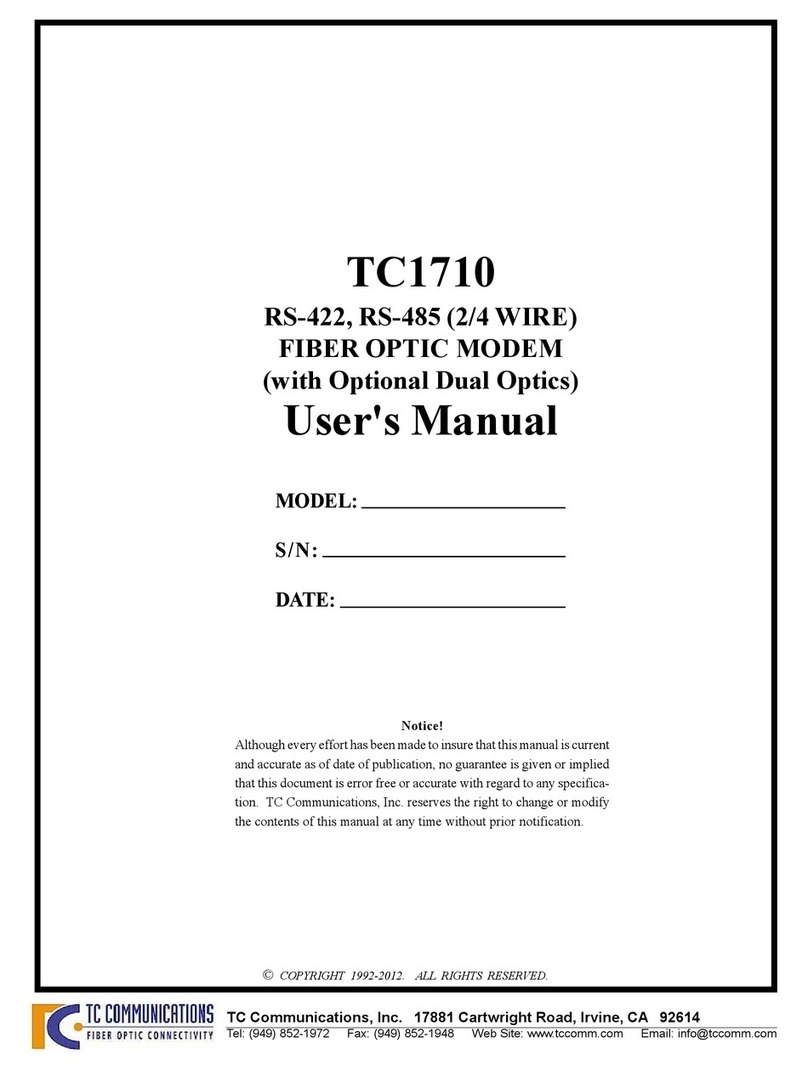
TC Communications
TC Communications TC1710 User manual
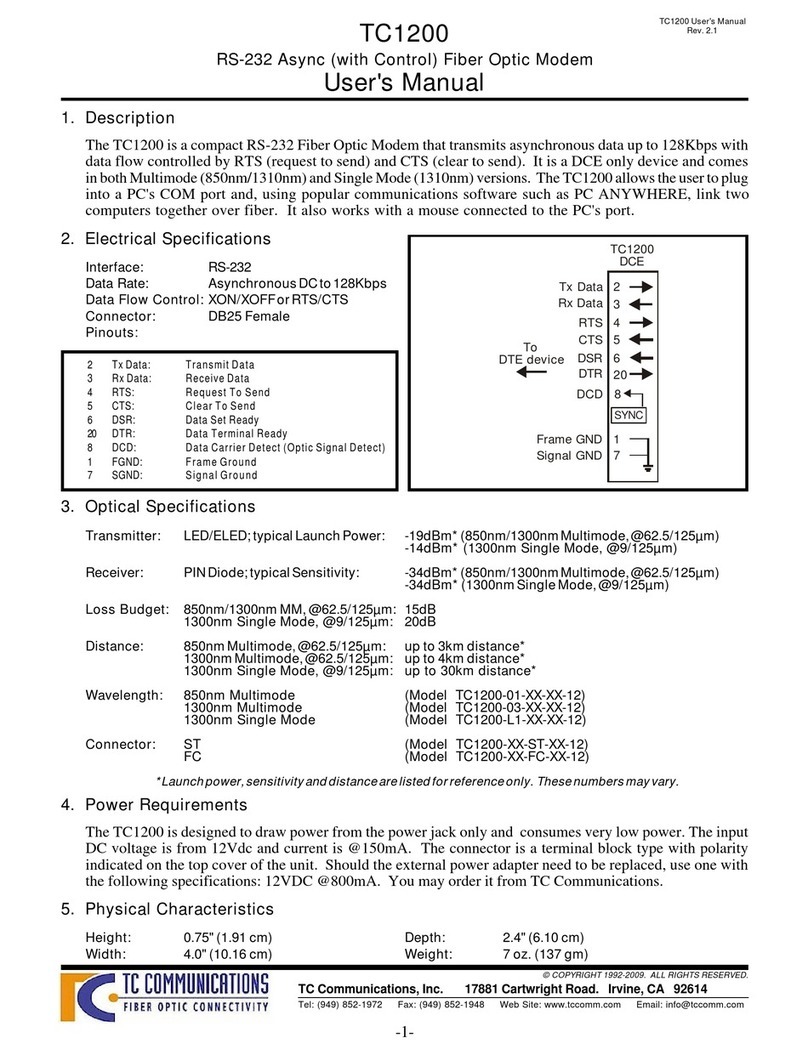
TC Communications
TC Communications TC1200 User manual

TC Communications
TC Communications TC2100 User manual
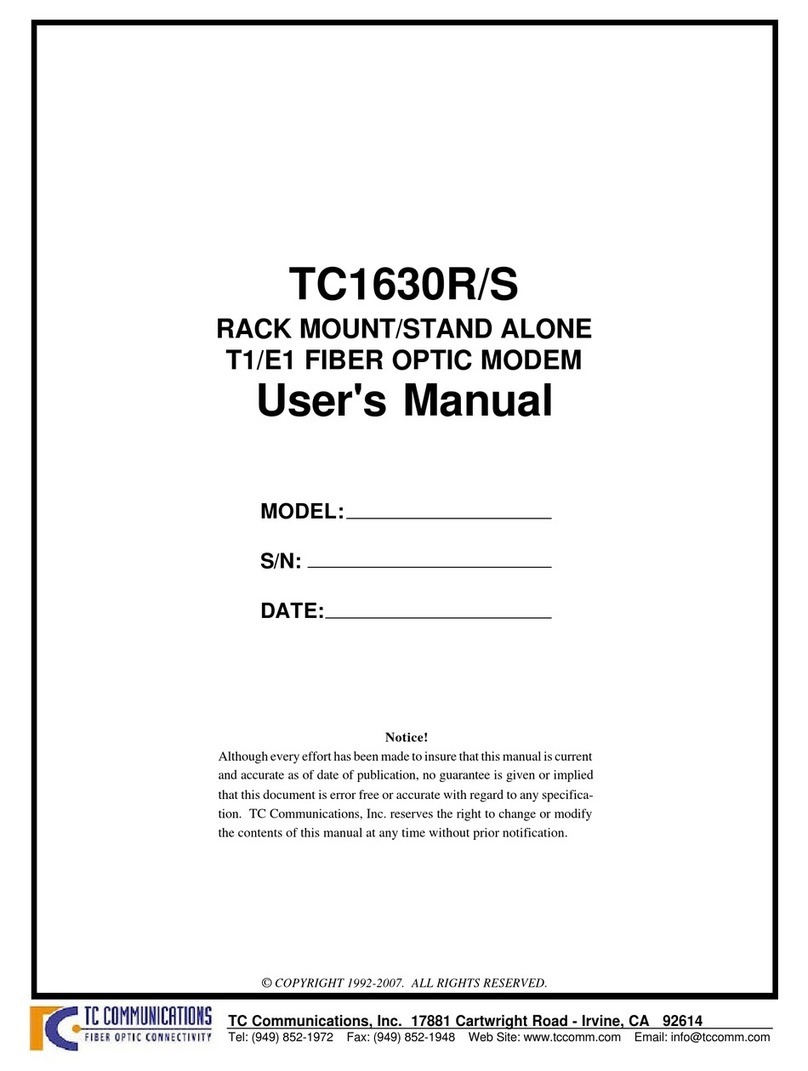
TC Communications
TC Communications TC1630R User manual
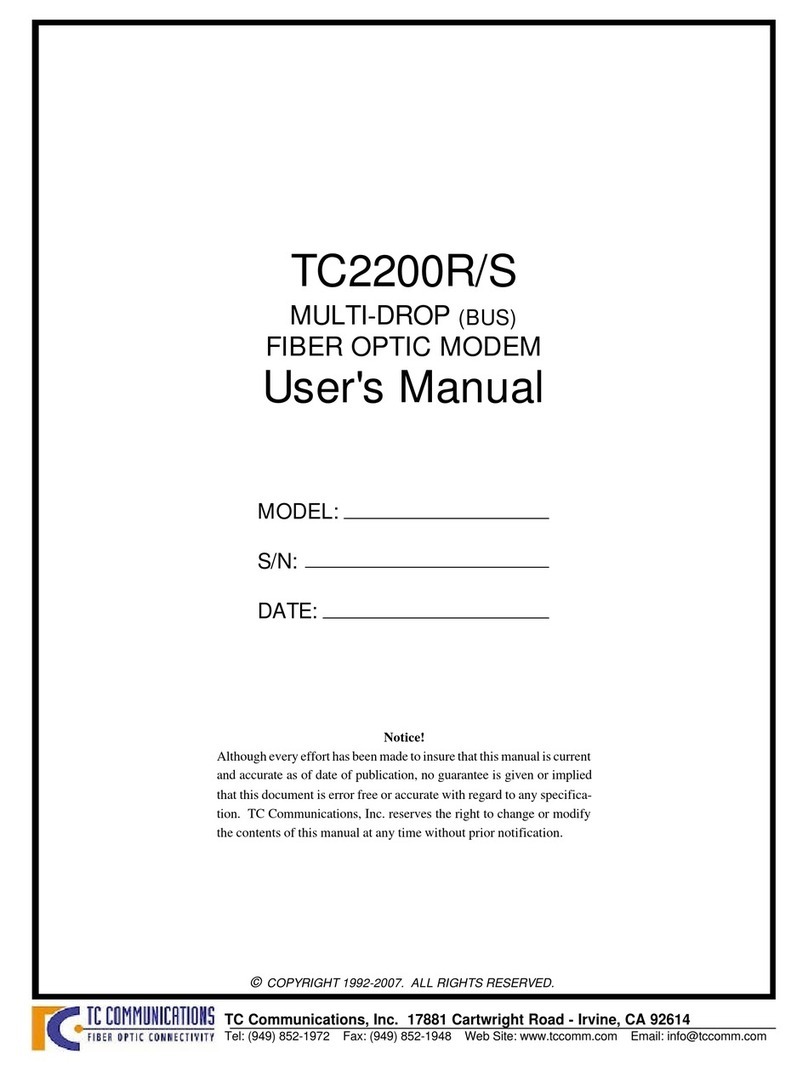
TC Communications
TC Communications TC2200R User manual
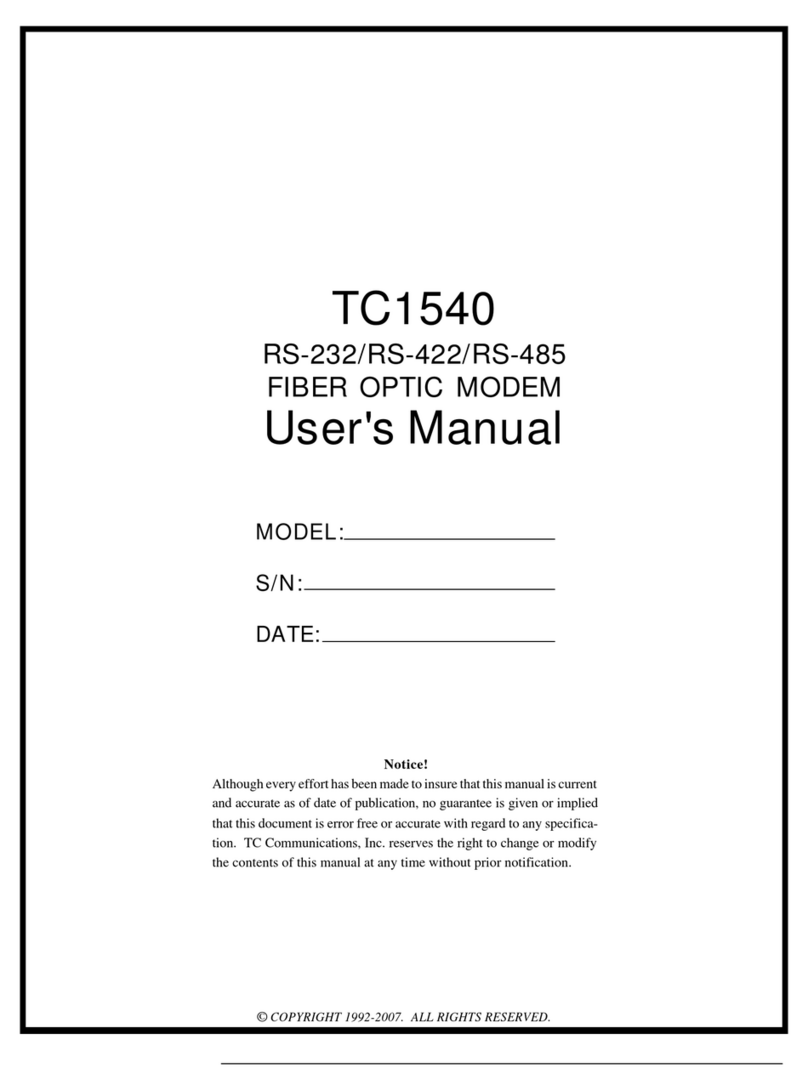
TC Communications
TC Communications TC1540 User manual
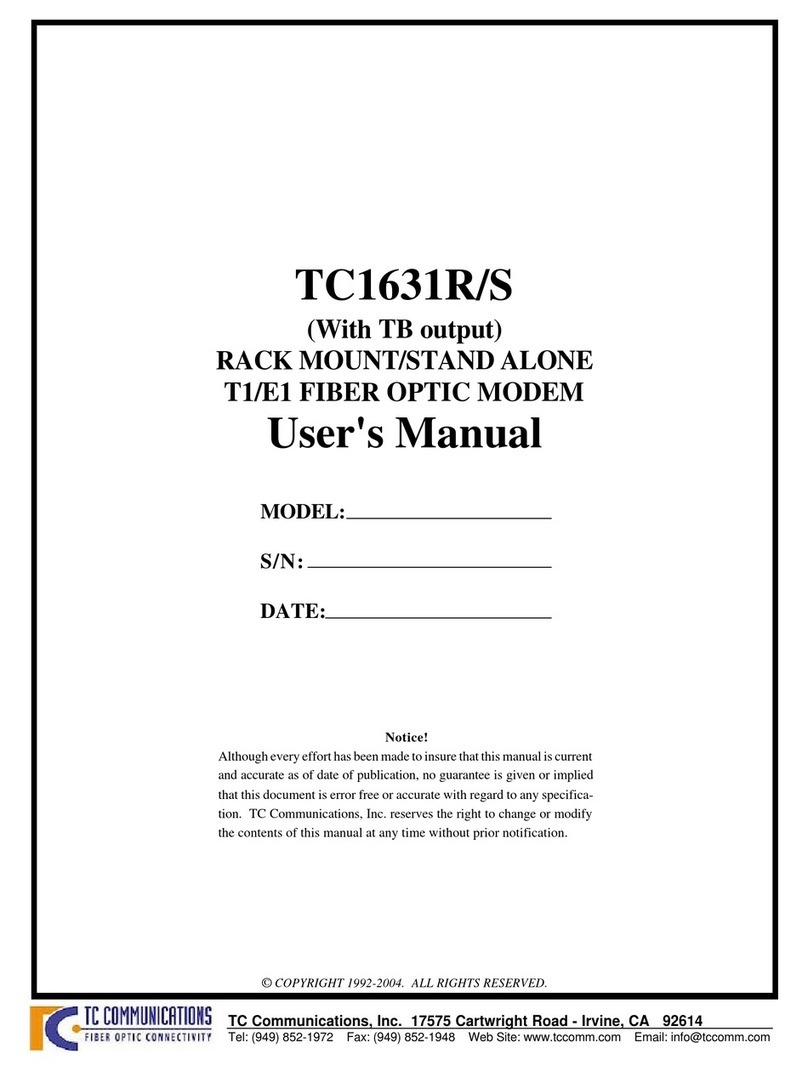
TC Communications
TC Communications TC1631R User manual
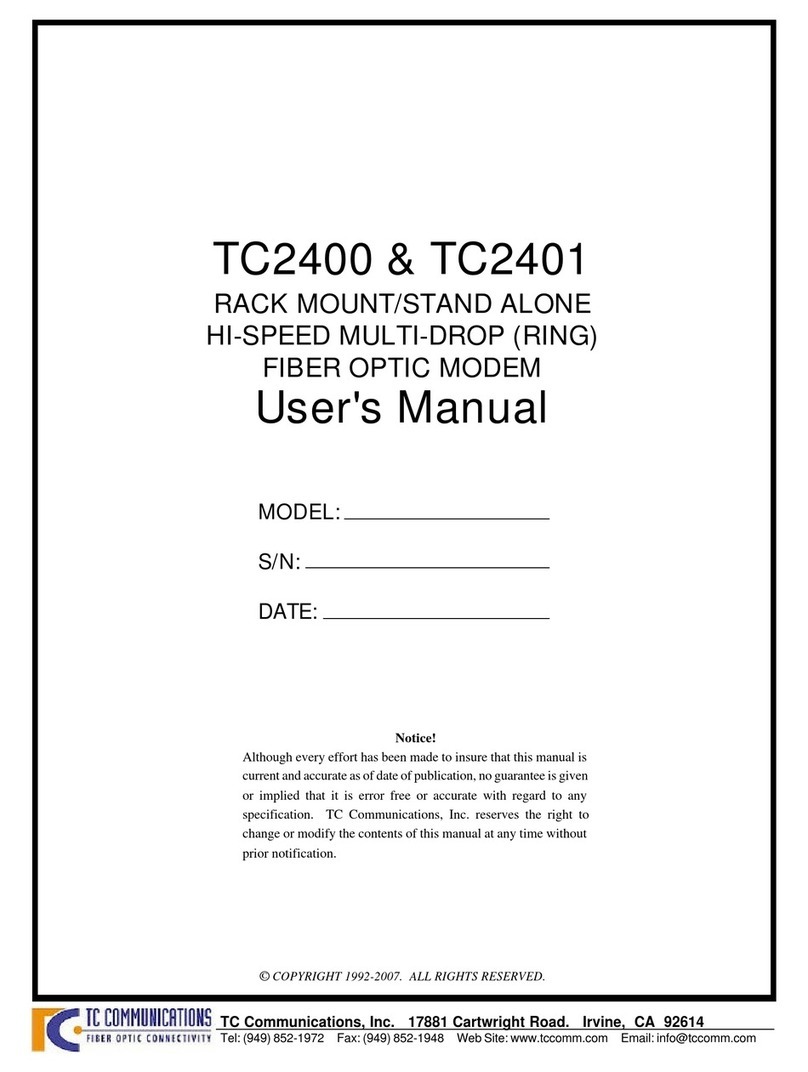
TC Communications
TC Communications TC2400 User manual


